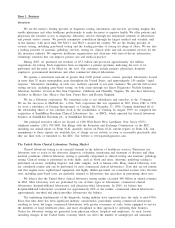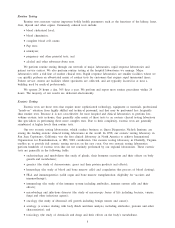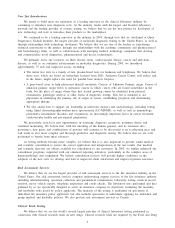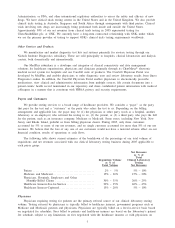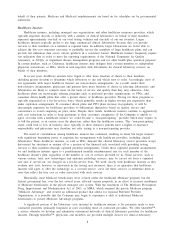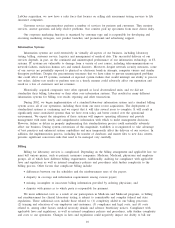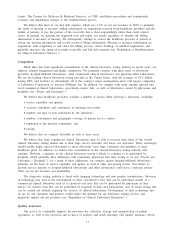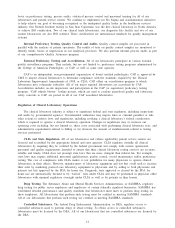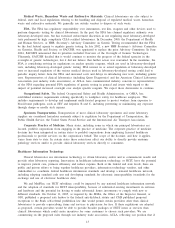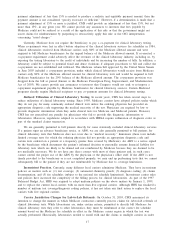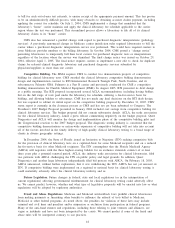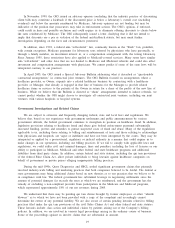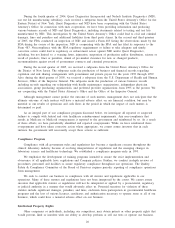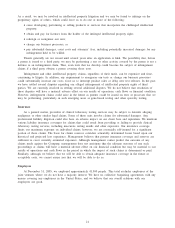Quest Diagnostics 2005 Annual Report Download - page 28
Download and view the complete annual report
Please find page 28 of the 2005 Quest Diagnostics annual report below. You can navigate through the pages in the report by either clicking on the pages listed below, or by using the keyword search tool below to find specific information within the annual report.clients. The Centers for Medicare & Medicaid Services, or CMS, establishes procedures and continuously
evaluates and implements changes to the reimbursement process.
We believe that most of our bad debt expense, which was 4.2% of our net revenues in 2005, is primarily
the result of missing or incorrect billing information on requisitions received from healthcare providers and the
failure of patients to pay the portion of the receivable that is their responsibility rather than credit related
issues. In general, we perform the requested tests and report test results regardless of whether the billing
information is incorrect or missing. We subsequently attempt to contact the healthcare provider or patient to
obtain any missing information and rectify incorrect billing information. Missing or incorrect information on
requisitions adds complexity to and slows the billing process, creates backlogs of unbilled requisitions, and
generally increases the aging of accounts receivable and bad debt expense (see “Regulation of Reimbursement
for Clinical Laboratory Services’’).
Competition
While there has been significant consolidation in the clinical laboratory testing industry in recent years, our
industry remains fragmented and highly competitive. We primarily compete with three types of laboratory
providers: hospital-affiliated laboratories, other commercial clinical laboratories and physician-office laboratories.
We are the leading clinical laboratory testing provider in the United States, with net revenues of $5.5 billion
during 2005, and facilities in substantially all of the country’s major metropolitan areas. Our largest competitor
is Laboratory Corporation of America Holdings, Inc. In addition, we compete with many smaller regional and
local commercial clinical laboratories, specialized esoteric labs, as well as laboratories owned by physicians and
hospitals (see “Payers and Customers’’).
We believe that healthcare providers consider a number of factors when selecting a laboratory, including:
•service capability and quality;
•accuracy, timeliness and consistency in reporting test results;
•number and type of tests performed by the laboratory;
•number, convenience and geographic coverage of patient service centers;
•reputation in the medical community; and
•pricing.
We believe that we compete favorably in each of these areas.
We believe that large commercial clinical laboratories may be able to increase their share of the overall
clinical laboratory testing market due to their large service networks and lower cost structures. These advantages
should enable larger clinical laboratories to more effectively serve large customers and members of large
healthcare plans. In addition, we believe that consolidation in the clinical laboratory testing industry will
continue. However, a majority of the clinical laboratory testing is likely to continue to be performed by
hospitals, which generally have affiliations with community physicians that refer testing to us (see “Payers and
Customers – Hospitals’’). As a result of these affiliations, we compete against hospital-affiliated laboratories
primarily on the basis of service capability and quality as well as other non-pricing factors. Our failure to
provide service superior to hospital-affiliated laboratories and other laboratories could have a material adverse
effect on our net revenues and profitability.
The diagnostic testing industry is faced with changing technology and new product introductions. Advances
in technology may lead to the development of more cost-effective tests that can be performed outside of a
commercial clinical laboratory such as (1) point-of-care tests that can be performed by physicians in their
offices; (2) esoteric tests that can be performed by hospitals in their own laboratories; and (3) home testing that
can be carried out without requiring the services of clinical laboratories. Development of such technology and
its use by our customers and patients would reduce the demand for our laboratory testing services and
negatively impact our net revenues (see “Regulation of Clinical Laboratory Operations’’).
Quality Assurance
Our goal is to continually improve the processes for collection, storage and transportation of patient
specimens, as well as the precision and accuracy of analysis and result reporting. Our quality assurance efforts
11


